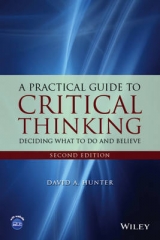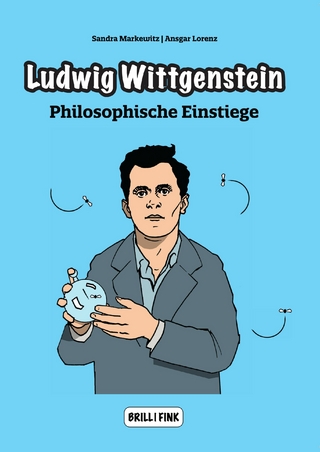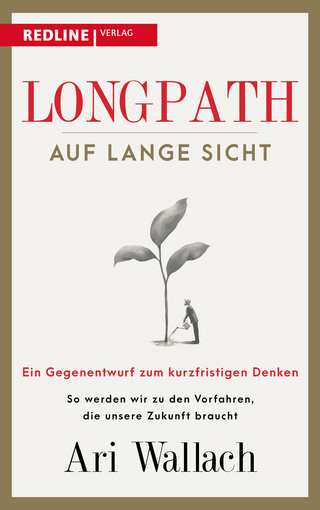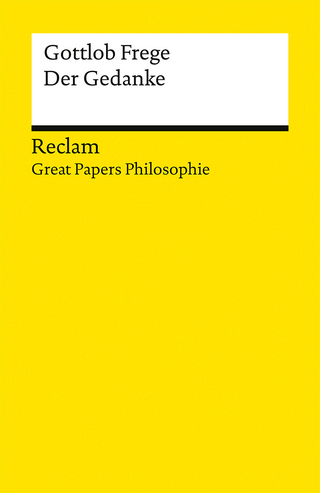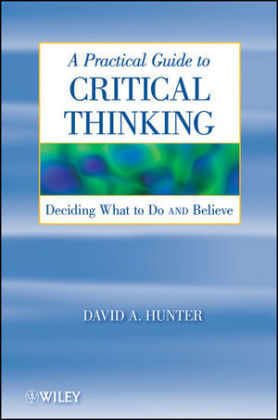
A Practical Guide to Critical Thinking
Wiley-Blackwell (Verlag)
978-0-470-16757-1 (ISBN)
- Titel ist leider vergriffen;
keine Neuauflage - Artikel merken
A practical introduction to critical thinking across various disciplines Knowing how to think critically about what to believe and what to do is essential for success in both academic and professional environments. A Practical Guide to Critical Thinking introduces readers to the concepts, methods, and standards for thinking critically about reasons and arguments in virtually any area of practice. While most literature on critical thinking focuses on its formal applications within philosophy, this book offers a broad conception of critical thinking and explores its practical relevance to conducting research across a wide variety of disciplines, including business, education, and the biological sciences. While the book pursues an interdisciplinary approach to critical thinking, providing examples and illustrations from diverse subjects and fields of research, it also provides strategies to help readers identify the methods and standards that are characteristic of critical thinking in their chosen branches of learning, in their workplace, and in their own lives.
The concept of an argument is extended beyond its philosophical roots to include experimentation, testing, measurement, policy development and assessment, and aesthetic appreciation as activities that require critical thinking. The logical, core concepts of critical thinking are presented in a rigorous yet informal way, with creative and practical strategies for defining, analyzing, and evaluating reasons and arguments wherever they are found. Each chapter ends with a "Mistakes to Avoid" section as well as a variety of exercises designed to help readers integrate and extend the chapter's lessons. A Practical Guide to Critical Thinking is an excellent book for courses on critical thinking and logic at the upper-undergraduate and graduate levels. It is also an appropriate reference for anyone with a general interest in critical thinking skills.
David A. Hunter, PhD, is Associate Professor of Philosophy at Ryerson University, Canada. He has published numerous journal articles in his areas of research interest, which include the philosophy of language, the philosophy of mind, epistemology, and critical thinking.
Preface. Note to Instructors. Chapter 1: The Nature and Value of Critical Thinking. 1.1 The Nature of Critical Thinking. Exercise 1.1. 1.2 Critical Thinking and Knowledge. Exercise 1.2. 1.2.1 Truth. 1.2.1.1 Realism, Relativism and Nihilism. 1.2.1.2 Relativism and The Argument from Disagreement. 1.2.2 Belief. 1.2.3 Justification. 1.2.3.1 Emotional and Pragmatic Reasons. 1.2.3.2 Epistemic Reasons. 1.2.4 Good Reasons are Sufficient and Acceptable. 1.2.4.1 When Evidence Conflicts. Exercise 1.2. 1.3 Critical Thinking and Personal Autonomy. 1.3.1 Belief and Prejudice. 1.3.2 Making up your Own Mind. Exercise 1.3. 1.4 Mistakes to Avoid. 1.5 Practical Strategies. 1.6 From Theory to Practice: applying what we have been learning. Chapter 2 Clarifying Meaning. 2.1 The Place of Definitions in Critical Thinking. 2.2 Assertion. 2.2.1 Propositions. Exercise 2.2.1. 2.2.2 Assertion Test. Exercise 2.2.2. 2.3 Constructing and Evaluating Definitions. 2.3.1 Slogan. 2.3.1.1 Necessary and Sufficient Conditions. 2.3.1.2 Necessary and Sufficient Conditions are Related in Complex Ways. 2.3.1.3 Narrow and Broad Definitions. 2.3.1.4 Definitions in Practical Life. Exercise 2.3.1. 2.3.2 Expand. 2.3.3 Examples. 2.3.4 Contrast. Exercise 2.3. 2.4 Thinking Critically about Frameworks. Exercise 2.4. 2.5 Clarifying Beliefs and Problems. Exercise 2.5. 2.6 Technical Definitions. 2.7 Meaning in Advertisements. Exercise 2.7. 2.8 Mistakes to Avoid. 2.9 Practical Strategies. 2.10 From Theory to Practice: applying what we have learned. Chapter 3 Sufficient Reasons. 3.1 Critical Thinking and Arguments. Exercise 3.1. 3.2 Identifying Premises and Conclusions. Exercise 3.2. 3.3 Dependent and Independent Premises. 3.3.1 The Words Test. 3.3.2 The False Premise Test. 3.3.3 Circumstantial Reasons. Exercise 3.3. 3.4 Sub-Arguments. Exercise 3.4. 3.5 Evaluating Logical Support. Exercise 3.5. 3.6 Missing Premises. Exercise 3.6. 3.7 Practical Strategies. 3.8 From theory to Practice: applying what we have learned. Chapter 4 Acceptable Reasons. 4.1 Reliable Evidence. 4.1.1 Reliability. 4.1.2 Undermining and Overriding Evidence. Exercise 4.1. 4.2 Observation. 4.3 Memory. Exercise 4.3. 4.4 Testimony. 4.4.1 Appropriate Testimony. 4.4.2 Competent Testimony. 4.4.3 Unbiased Testimony. 4.4.4 Advertizing. 4.4.5 News Reports. Exercise 4.4. 4.5 Measurement. 4.5.1 Measurement Consistency. 4.5.2 Measurement Precision. 4.5.3 Surveys. Exercise 4.5. 4.6 Mistakes to Avoid. 4.7 Practical Strategies. 4.8 From Theory to Practice: applying what we have learned. Chapter 5 Reasoning about Alternatives and about Necessary and Sufficient Conditions. 5.1 Reasoning about Alternatives. 5.1.1 The Meaning of Disjunctions . 5.1.2 Denying a Disjunct. 5.1.3 False Disjunctions. 5.1.4 When are Disjunctions Acceptable?. 5.1.5 Exclusive Disjunctions. 5.1.6 Criticizing Reasoning about Alternatives. Exercise 5.1 . 5.2 Reasoning about Necessary and Sufficient Conditions. 5.2.1 The Meaning of Conditionals. 5.2.1.1 Sufficient Conditions. 5.2.1.2 Necessary Conditions. 5.2.1.3 Necessary and Sufficient Conditions. Exercise 5.2.1. 5.2.2 Valid Forms of Reasoning about Necessary and Sufficient Conditions. 5.2.3 Invalid Forms of Reasoning about Necessary and Sufficient Conditions. 5.2.4 Making it Explicit. Exercise 5.2.4. 5.2.5 When are claims about Necessary and Sufficient Conditions Acceptable?. 5.3 Reasoning with Definitions and Standards. 5.4 Reasoning about Causal Conditions. 5.4.1 The Meaning of Causal Claims. 5.4.2 Reasoning with Causal Claims. 5.4.3 When are Causal Claims Acceptable?. 5.4.3.1 Discovering Necessary Causal Conditions. 5.4.3.2 Discovering Sufficient Causal Conditions. 5.4.3.3 Discovering Necessary and Sufficient Causal Conditions. 5.3.4.4 Concomitant Variation. 5.3.4.5 Experimenting and Simulating. Exercise 5.4. 5.5 Mistakes to Avoid. 5.6 Practical Strategies. Chapter 6 Reasoning by Analogy. 6.1 Reasoning by Analogy. 6.1.1 Some Examples. 6.1.2 Is Reasoning by Analogy valid?. 6.1.3 Relevant Similarity. 6.1.4 When is an Analogical Claim True?. Exercise 6.1. 6.2 Reasoning using Representational Analogy. 6.2.1 Reasoning with Samples. 6.2.2 When are Samples Representative?. 6.2.2.1 Sample Size. 6.2.2.2 Random Samples. 6.2.2.3 Self-Selected Samples. 6.2.3 Reasoning with Maps and Models. Exercise 6.2. 6.3 Mistakes to Avoid. 6.4 From Theory to Practice: applying what we have learned. Chapter 7 Critical Thinking in Action . 7.1 Thinking Critically about a Discipline. 7.1.1 Identifying a Discipline's Key Concepts. 7.1.2 Clarifying a Discipline's Key Concepts. Exercise 7.1.2. 7.1.3 Identifying a Discipline's Sources of Evidence. Exercise 7.1.3. 7.1.4 Identifying a Discipline's Modes of Reasoning. 7.2 Critical Thinking Questions. 7.3 Thinking Critically in your own Decision Making. 7.3.1 Clarify your Views. 7.3.2 Clarify your Reasons. 7.3.3 Show that your Reasons are Acceptable and Sufficient. 7.3.4 Identify and Respond to Alternatives. 7.4 Thinking Critically in Discussion. 7.4.1 Ask Open-Ended Clarification Questions. 7.4.2 Withhold Disagreement and Agreement. 7.4.4 Keep Emotional Distance. 7.5 From Theory to Practice: applying what we have learned. Appendix A. Mistakes to Avoid. Appendix B. Practical Strategies.
| Zusatzinfo | Illustrations |
|---|---|
| Verlagsort | Hoboken |
| Sprache | englisch |
| Maße | 162 x 233 mm |
| Gewicht | 420 g |
| Einbandart | Paperback |
| Themenwelt | Geisteswissenschaften ► Philosophie ► Logik |
| Mathematik / Informatik ► Mathematik | |
| Sozialwissenschaften ► Pädagogik | |
| ISBN-10 | 0-470-16757-2 / 0470167572 |
| ISBN-13 | 978-0-470-16757-1 / 9780470167571 |
| Zustand | Neuware |
| Haben Sie eine Frage zum Produkt? |
aus dem Bereich
